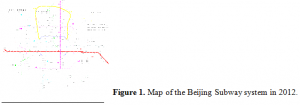Gregory Macfarlane and Dr. G. Grant Schultz, Civil and Environmental Engineering
This paper reports on transportation planning and engineering research sponsored by the Office of Research and Creative Activities (ORCA) at Brigham Young University (BYU). The subject of this research is the Transportation Plan for the 2008 Summer Olympic Games in Beijing, China, specifically the sustainable development strategies employed in this plan. Using foreign investment and expertise, Beijing used the Olympics to meet its current transportation needs as well as prepare for future economic expansion.
Beginning in the middle 1980’s, China has opened itself to foreign investment and capitalist-style business practices. The macroscopic result of this has been double-digit economic growth in the last two decades. One microscopic effect of the economic growth is the need for modern, reliable, and efficient transportation. Beijing and the national government used the attention garnered through hosting the Olympics to provide critical infrastructure improvements and prepare for the future.
Using the Olympics to construct new transportation infrastructure is not a new idea. Salt Lake City, Utah, the host of the 2002 Winter Olympics, received US$ 1.6 billion from the federal government to reconstruct Interstate-15 in preparation for the Olympics ( ). Additionally, Salt Lake City installed a Light Rail Transit (LRT) facility with the knowledge that it would assist Olympics spectators in their transportation needs. Beijing, however, has taken Olympic investment to an entirely new level, spending almost US$ 40 billion on transportation projects at the global, regional, and local levels.
Global- The Beijing Capital International Airport has been slowly expanded since its opening as demand for its use has grown. The annual passengers index for the airport has skyrocketed in the last few years, to the 9th busiest airport in the world ( ). This outstanding traffic growth, combined with the Olympic host selection, led the city to announce the construction of a new Terminal 3 to host international air traffic and be the home of Air China, the state airline. The terminal is the single largest passenger terminal in the world, with an area larger than all five of the terminals at London’s Heathrow Airport. The terminal has a gross floor area of 930,000 m2, and with the addition of a third runway in 2012 will bring capacity to 90 million passengers, allowing Beijing to potentially be the world’s busiest airport ( ).
Regional- Beijing is the centerpiece in China’s extensive and overburdened rail network. China’s rails account for 26% of global rail traffic, and yet only 6% of global rail length ( ). Beijing is using the Olympics to add two pins to the city’s rail network, a new terminal station and an airport express rail. The new Beijing South Railway Station is currently under construction, with an August 1st, 2008 opening date. Capable of handling 500,000 passengers a day, the station will also be home to the high-speed rails connecting Beijing to the economically important cities of Tianjin and Shanghai (the Tianjin route is expected to be opened by the Olympics). The airport express train is a new high-speed link between the Dongzhimen subway hub and Terminals 2 and 3 of the airport. The rail takes passengers from downtown Beijing to the airport in less than 20 minutes, on a driverless train (3).
Local- Beijing has one of the most extensive subway plans in the world. Beginning with one line constructed in the 1960’s and a second built in the 1970’s, the urban rail system was already in dire need of serious renovation and expansion when the city got the Olympic selection. Below in Figure 1 is a diagram of the additional lines that will be built in Beijing by 2012, but it should be remembered that the catalyst of this growth is the Beijing Olympics. Several lines were given priority so as to facilitate the movement of Olympic spectators, but the plans were made considering long-term sustainable development needs. In terms of highway traffic, Beijing is very congested during workdays, and the Olympic Committee had a great challenge in assuring that Olympic visitors and staff could travel quickly between venues while the city continued its normal functions. Olympic money was focused on improving collector roads between the second and fourth ring roads ( ). The municipality itself enforced a temporary law that residents could only drive their automobile every other day, but as traffic situations deteriorate, some Chinese professionals believe that the policy may be made permanent ( ).
Beijing is taking the opportunities provided through its selection as the host city for the Olympics to strengthen sustainable transportation development and planning. Other cities may look to Beijing as a model not just for mega-transportation events challenges, but also for strategies and solutions in all types of sustainable transportation planning.

